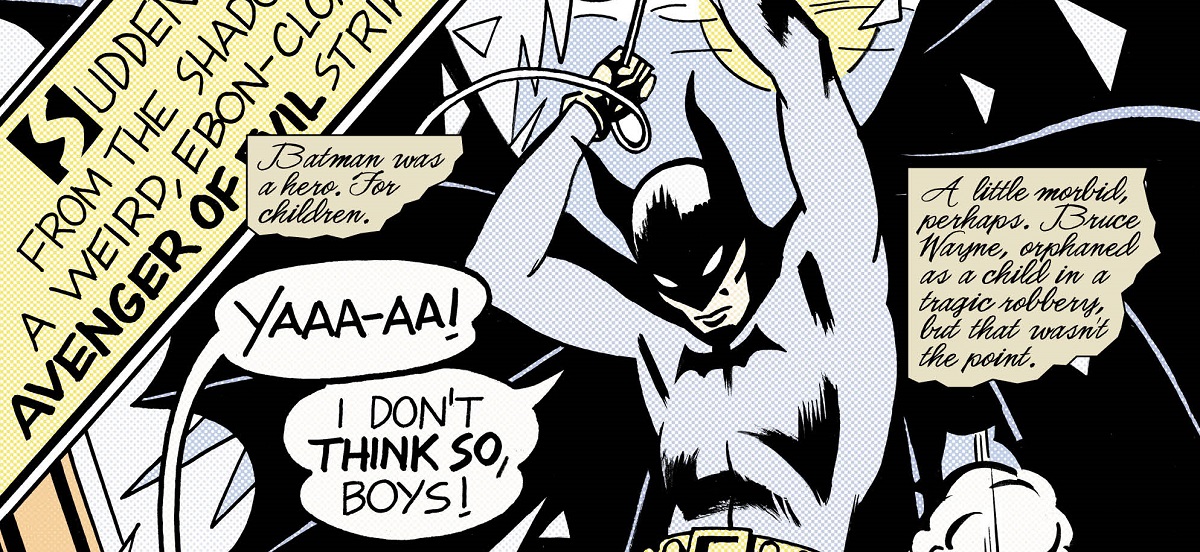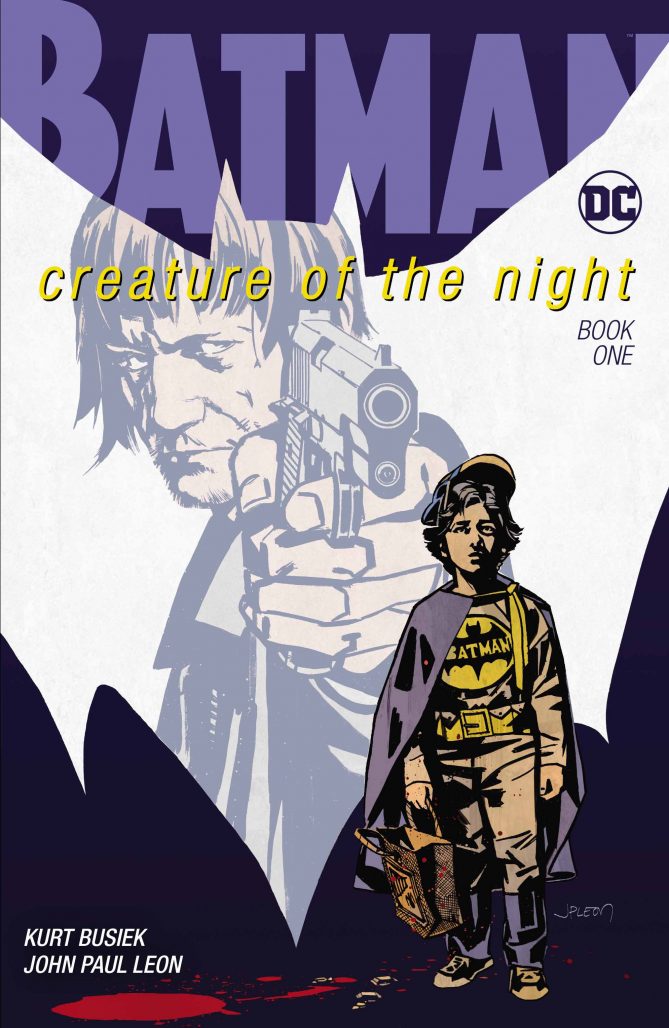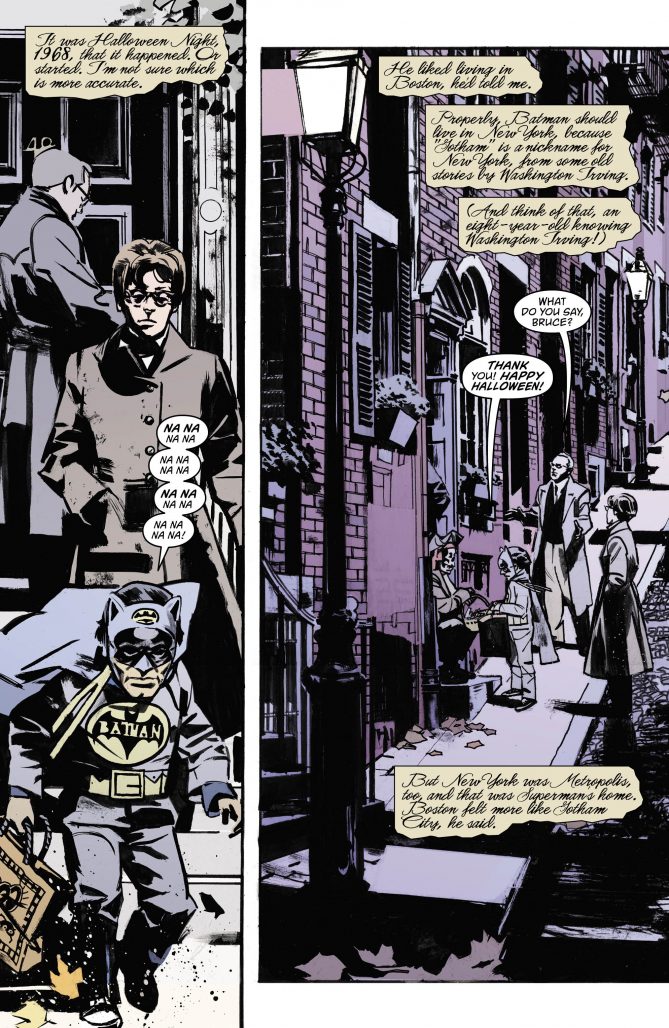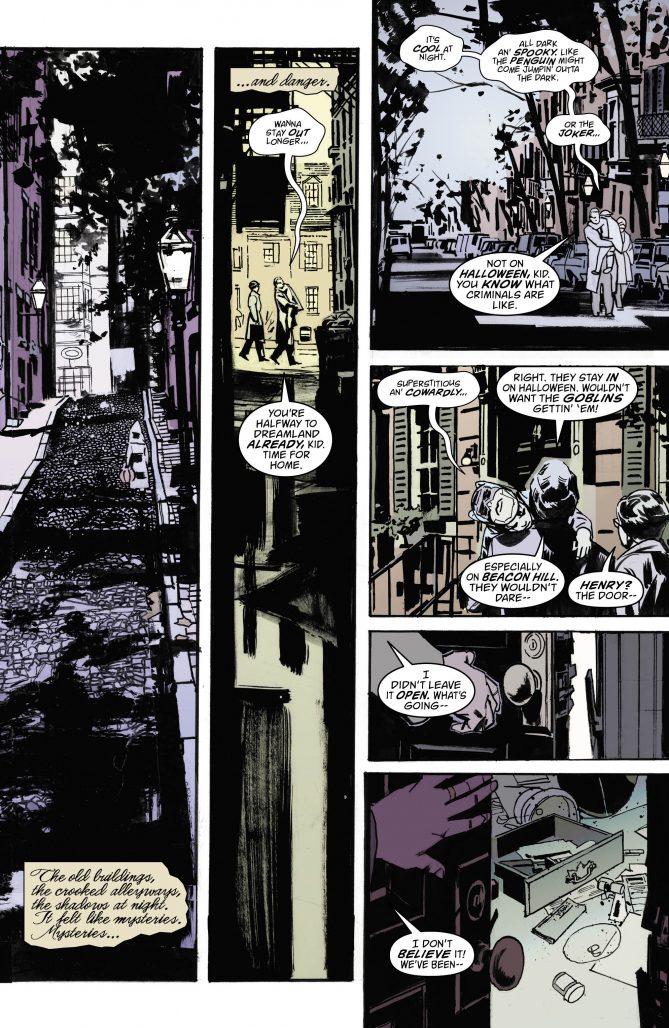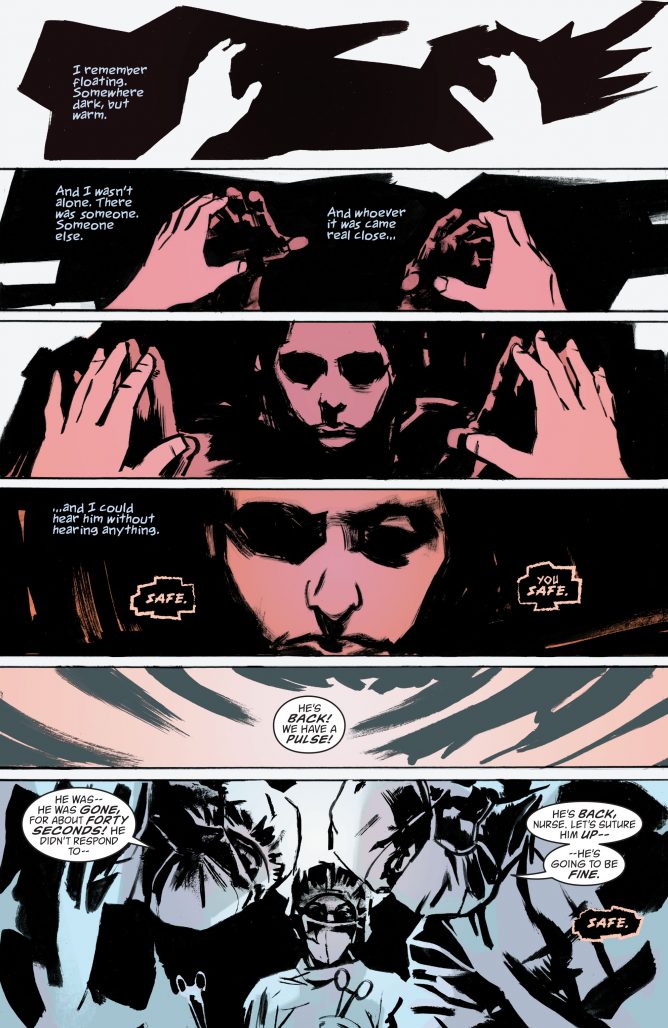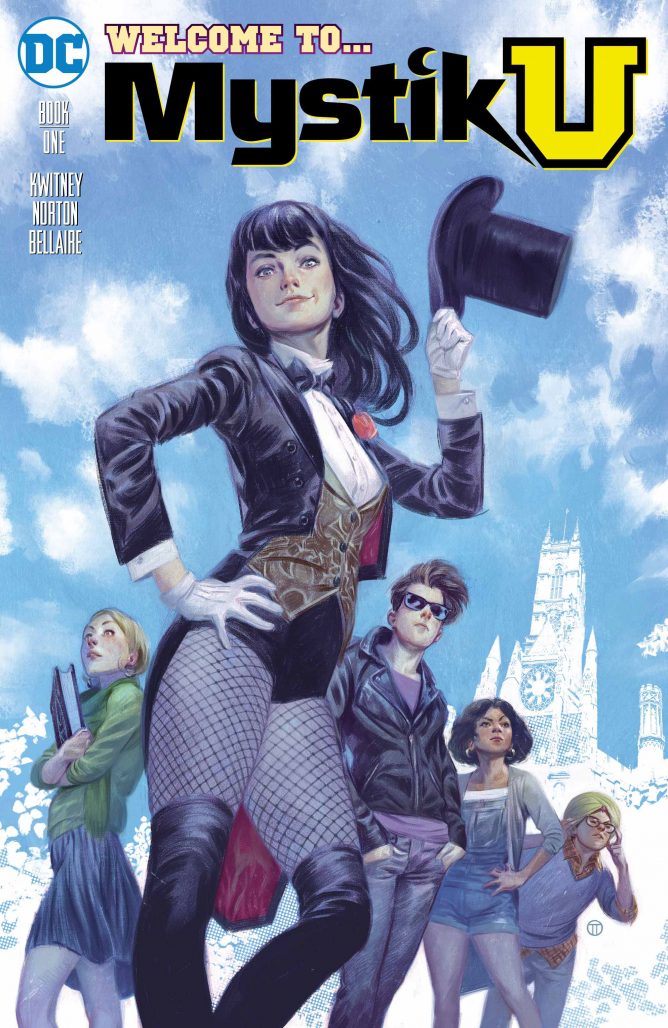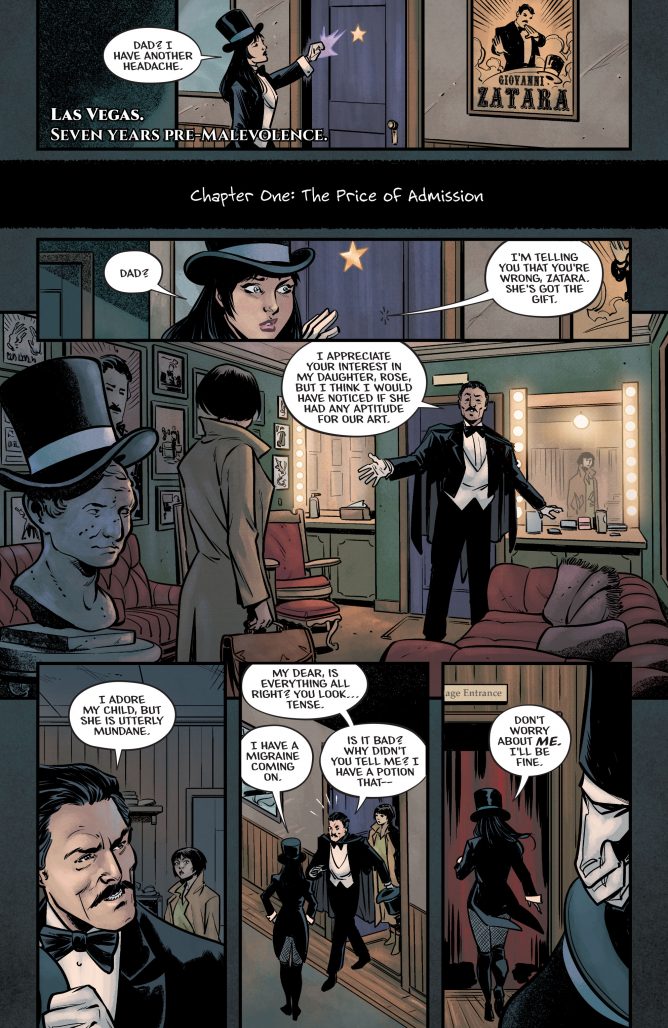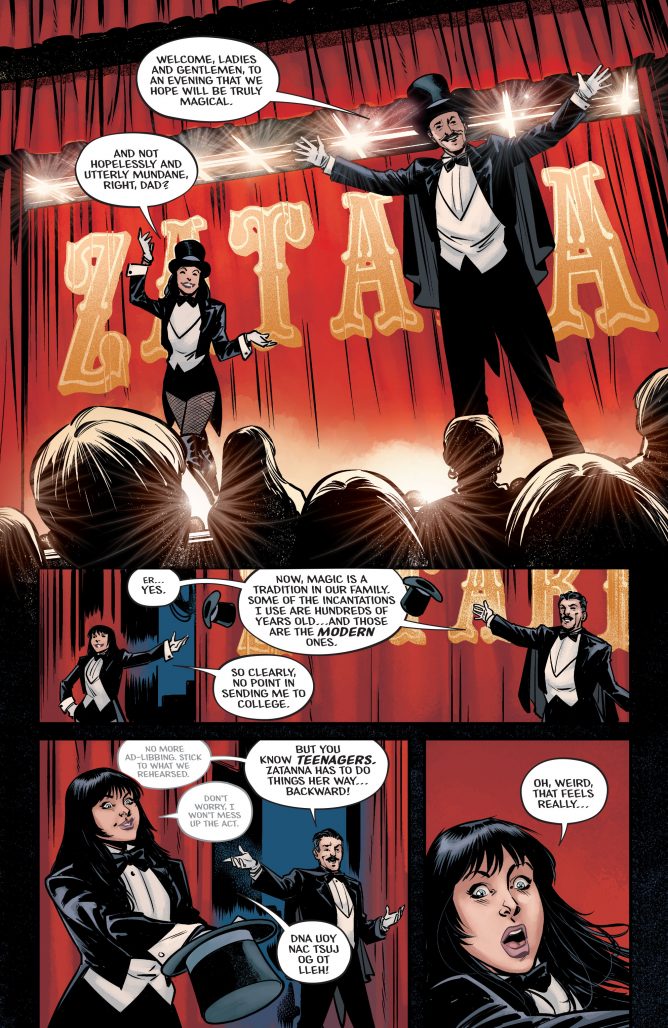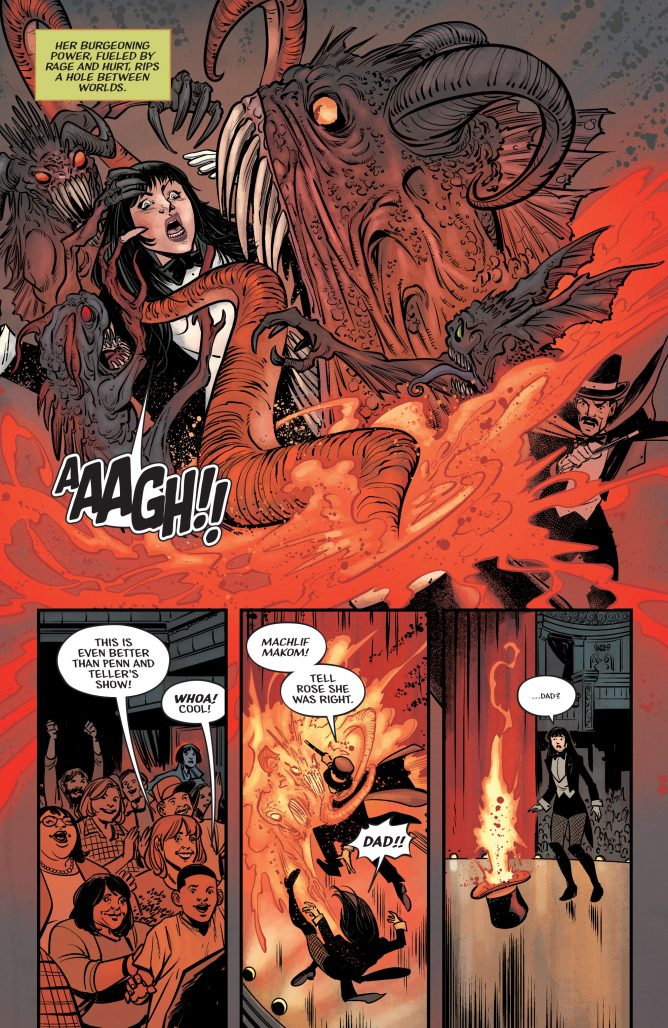In June 2016, DC Comics kicked off the start of its Rebirth initiative. After a wave of criticism surrounding the way they have treated their characters’ rich histories since 2011’s New 52 relaunch, DC has decided to rebrand. They hope that by restoring their characters’ pasts, they will restore readers’ faith in them as well. Do they succeed? That’s what the Comics Beat managing editor Alex Lu and entertainment editor Kyle Pinion, and contributor Louie Hlad are here to discuss. Book by book. Panel by panel.
THIS WEEK: Alex tackles Mystik U #1 and Batman: Creature of the Night #1, two new limited series that reimagine DC characters and channel their essences into unique genre stories.
Note: the reviews below contain **spoilers**. If you want a quick, spoiler-free buy/pass recommendation on the comics in question, check out the bottom of the article for our final verdict.
 Batman: Creature of the Night #1
Batman: Creature of the Night #1
Writer: Kurt Busiek
Artist: John Paul Leon
Letterer: Todd Klein
When I was in college, I contemplated writing a senior thesis on the employment of Gothic literary tropes in comic books. At NYCC that year, I learned that that idea had already been turned into a book (c’est la vie), but as a longtime Batman fan and fan of Gothic literature, the idea has stuck with me over the years. The core of the Gothic movement is the idea that our internal fears can manifest as external realities. The beating heart of a dead man’s body as a symbol of a murder’s guilt. A respectable man who transforms into a devious beast, reflecting the duality inside each of us. No character in superhero comics represents fear externally more than the Batman himself, so it’s no wonder that we should eventually see a book like Batman: Creature of the Night, which takes the idea behind the character and reframes it in an even more horrific and spiritual way than we’ve seen before.
At the onset, Creature of the Night #1 appears to be a retelling of the classic Batman origin– the twist to it being that the story is set in the real world. Bruce Wayne is recast as a pre-teen Bruce Wainwright, the son of two upper middle-class parents in Boston. His uncle is Alton Frederick (Al…fred, get it?) and he is utterly fascinated by the connections he makes in his life to the Batman comics he reads. This sort of metafictional layering works to a certain extent– particularly when certain things like setting the story in Boston instead of New York, the “real” Gotham, are lampshaded– but by and large, the early parallels between Wayne and Wainwright are a bit too blunt for my taste. It’s not that the parallels between characters in the story’s reality and classic Batman comics are bad, necessarily, but they make the origin story being told here much less interesting to trudge through. Yes, the Wainwright parents get shot. Yes, Bruce Wainwright ends up travelling a lot and building a wide skillset while nursing his inner demons– albeit at a younger age than his Wayne counterpart did. The differences, while there, aren’t quite stark enough to make yet another Batman origin story compelling.
The way that the story is told to us doesn’t help, either. Most of the story is presented through narration– either in the form of Bruce’s internal monologue or Alton Frederick’s. I’m personally not a big fan of caption boxes in comics in general, so their liberal usage is a bit of a turnoff, though it is ultimately helpful in establishing the moody, gothic feel of the book. My major annoyance with this mechanic, as employed here, is that the lettering used for Frederick’s captions is difficult to read. It’s a clumpy cursive script which is visually apt for the character, but painfully difficult to understand as a reader. It makes an already slow start even slower.
In spite of these major starting line misfires, however, I really enjoyed Batman: Creature of the Night #1. A large part of that is thanks to artist John Paul Leon. Leon, of Mother Panic fame, turns in some of the best work of his career so far in this book. His dark, ink heavy style is perfect for setting the Gothic noir tone for the story. His work is evokes the styles of Alias-era Michael Gaydos or Tommy Lee Edwards, who also worked on Mother Panic. However, Leon exerts a little more control over his blacks in this story than Edwards did in Mother Panic and gives Creature of the Night a little more polish than Gaydos did Alias. The result is a visual mode that is primarily focused on mood over realism yet simultaneously retains the ability to create characters whose faces are both recognizable and empathetic at a momentary glance.
Moreover, while the story’s initial offerings are relatively par for the course when it comes to a Batman origin story, as it unveils its true premise, the stakes and my enjoyment of the book escalate dramatically. As it turns out, in Creature of the Night, the Batman is not a man dressed as a bat. He’s actually something far more mysterious and horrific. He’s a shadowy creature of vengeance and appears to be a physical manifestation of Bruce Wainwright’s psyche. Instead of fighting criminals as a fully grown adult, the young Wainwright boy gets wield this unstoppable force of nature based upon his whims. This is a cool premise for a story. It’s much more in line with something like Death Note, aiming to explore morality and the nature of “objective” justice through the lens of someone clouded by personal perspective.
Batman: Creature of the Night #1 is not a perfect book. There’s a lot of relatively uncompelling backstory one has to get through to get to the point. But if you’re willing to make that journey there’s quite a compelling surprise waiting for you at this leg’s end. Fingers crossed that the creative team keeps up this momentum in the installments to come.
Verdict: Buy
 Mystik U #1
Mystik U #1
Writer: Alisa Kwitney
Artist: Mike Norton
Colorist: Jordie Bellaire
Letterer: Deron Bennett
There’s something charming about Mystik U. It casts a spell on you right from the start. It’s captivating. It’s goddamn magic in the DC Universe and I am cursed to have no objectivity about adoring the very thought.
For whatever reason, stories about magic and spellcasters tend to get the short thrift with Marvel and DC Comics audiences. Historically, fantastical books like Justice League Dark or Doctor Strange have never done as well as their less overtly mystical counterparts. And that’s honestly a shame, because there’s something special about stories that explicitly play in the sandbox of the unexplainable– the forces in the world that, despite all our technology and reason, we don’t quite understand. Harry Potter combined the inexplicable with an intensely relatable story of a group of young kids coming into adolescence. In doing so, it captivated a generation. Now, the team behind Mystik U wants to do the same for a slightly older set– the young adults headed into college.
The thing that immediately strikes me about Mystik U is how much, in conceit, it feels like a Shakespearean play. As one of DC’s many Elseworlds comics, the series is not bound to traditional DC continuity. It’s free to play with the characters how it wishes and remake their identities. And in this case, some of DC’s greatest magicians have been recast as young adults just coming into their powers. They all end up at Mystik University in order to hone their skills as spellcasters. It’s fun to see classic DC characters like Zatanna and Enchantress get fresh starts. It’s hilarious to see others like Madame Xanadu and Frankenstein appear in the classroom as professors (Sandman‘s Cain and Abel even appear as school administrators). And it’s coolest to see a character like Sargon the Sorcerer, arguably culturally appropriative in his original incarnation, recast as a new character like Davit Sargon. These twists and turns to characters’ identities and roles give us a level of familiarity that makes us feel at home with the world of Mystik U while simultaneously revealing something new about the characters and properties we love.
Moreover, beyond just its premise, the series starts with two pretty dramatic kickers. The big one is “the Malevolence,” a mysterious evil being that, as we see at the start of this story, threatens to wipe out the entire world. We’re not told who the Malevolence is, but we are told that it’s one of our five protagonists– Zatanna, Davit Sargon, Enchantress, Sebastian Faust, or new character Pia Morales. The issue itself tells a pretty traditional YA story of self-discovery and growth, but this initial reveal hangs over the entire affair like a cloud, causing it to read like a mystery as we try to puzzle out which of these budding magicians might end up turning bad. That twist adds quite a bit of tension to the issue, as does our initial introduction to Zatanna.
When we first meet Zatanna, she hasn’t discovered her powers yet. She’s simply the stagehand to her father’s act. But one night after a behind the scenes spat, Zatanna’s power suddenly manifests and she accidentally sends her father to hell. That’s a pretty traumatic thing for any child to be saddled with– especially when she’s just coming into otherworldly powers that she doesn’t fully comprehend. And just as quickly as her father disappears, she’s whisked off to Mystik University with nary a moment to breathe. And she doesn’t get a chance to breathe– to explore that trauma and that theoretical loss (it’s handwaved away that her dad might be able to escape from hell)– throughout the entirety of this 48~ page affair. And that’s troubling to me because it feels like a lost character thread.
That brings me to my more central issue with Mystik U— which is that it feels a little compressed. The creative team on this title does something clever with the expanded space they’re given here, dividing the book into three distinct chapters rather than one continuous story. This allows them to skip around moments in time in the college semester implicitly rather than showcasing montages of kids in class or seasonal changes on campus. The hard part about saving valuable page space like this, however, is that we end up with a book that I logically understand is three distinct parts, but still feel as though it’s just one. And because I feel that way certain character developments feel a little rushed given what we see on the page. It’s not a problem unique to Mystik U in any way– really, it’s endemic to American comics in general– but it’s still a frustrating element of a book I otherwise quite adore.
In spite of my quibbles, however, I highly recommend Mystik U. It’s a distinctly fresh take on some of the best characters in the DC Universe that could use a little more attention. And if nothing else, you’ve gotta check out the book for Gerd, the greatest secondary character in the history of ever.
Verdict: Buy
Round-Up
I hope you all had a great Thanksgiving weekend. I’ve been a bit weighed down by some antibiotics which destroyed my stomach’s ecosystem, so I’ve spent most of my time learning about the wonders of probiotics. That said, there are a number of cool DC annuals out this week. Of particular note to me are the Batman Annual #2 and Green Arrow Annual #1. The former sees Tom King team up with artist Lee Weeks to tell a lovely cat and mouse story between the dark knight and his now fiancee Catwoman back in the early days of their careers. The latter sees Benjamin Percy alongside Eleonora Carlini, an artist whom I regret not being familiar with already because Carlini utterly astounds with the rendering of this windy, dreamy Christmas-centric Arrow family special.
Miss any of our earlier reviews? Check out our full archive!


